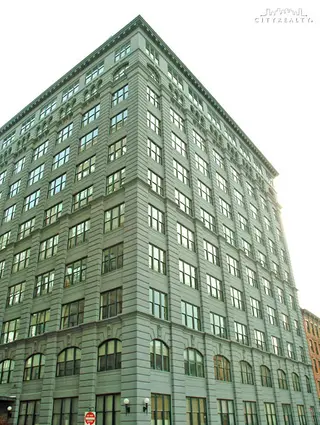 Carter Horsley
Carter HorsleyDec 23, 2011
Carter's Review
This former industrial building at 30 Main Street in Dumbo (Down Under the Manhattan Bridge Overpass) in Brooklyn was converted to residential condominiums in 2000 by Two Trees Management, which is headed by David Walentas.
The building, which is also known as 74-86 Water Street, is known as the Sweeney Building because it was erected by the W. H. Sweeney Manufacturing Company in 1908 at the northwest corner at Howard Alley.
The Sweeney company began buying property on the corner of Main and Water Streets in 1898 and by 1904 had bought the entire site. The company was founded by three brothers from Marysville, Ontario and it made brass, copper, nickel and silver kitchenware. The company had been established on Water Street in Manhattan before it moved to Brooklyn.
Sweeney did not fully occupy the building and a 1913 survey indicated that the Metal Packing Company, which made tin boxes, also occupied space in the building as did the Waitzfelder Braid Company the E. B. Kursheedt Apron Company, the C. S. Davisson & Company and the Wilson & Bradbury Company, both of which made handkerchiefs.
In 1924, according to the Dumbo Historic District designation report of the Landmarks Preservation Commission, "the Sweeney brothers retired from the manufacturing business and formed a realty company, with John J. Sweeney as head."
"The austere concrete façade, articulated by large window openings, rusticated piers, projecting cornice, and abstracted classically-inspired detail, marks 30 Main Street as an example of the Industrial Neo-Classical style," according to the report that listed the building's original architect as the Moyer Engineering and Construction Company.
The building has wide segmental-arch openings on the second story, each with three windows and triple round-arch windows in each bay on the tenth floor with the exception of end bays on each façade with single wide segmental-arch window.
The building has a fenced moat.
By the time the building opened in 2003, 70 percent of the 87 apartments had been sold. Half of the building's 8 penthouse units have spiral staircases to their own rooftop cabanas and the building also has six other cabanas on the building's 12th floor that were for sale to residents. Most of the penthouse cabanas contain more than 1,000 square feet.
John Fifeld of Fifeld Piaker Elman Architects designed the conversion.
Before its residential conversion, the building was used for the previous 15 years as offices of the New York City Human Resources Administration.
The lofts feature 11-foot ceilings, oversized windows, and kitchens outfitted with high-end stainless steel appliances; Sub-Zero, Thermador, Viking, Bosch, Broan and Franke, solid core birch doors custom designed hardware marble master baths with separate shower stalls and double sinks and fully outfitted laundry rooms.

- Condo built in 1908
- Converted in 2002
- 6 apartments currently for sale ($2.175M to $3.995M)
- Located in DUMBO
- 87 total apartments 87 total apartments
- 10 recent sales ($1.4M to $3.2M)
- Doorman
 6sqft delivers the latest on real estate, architecture, and design, straight from New York City.
6sqft delivers the latest on real estate, architecture, and design, straight from New York City.
